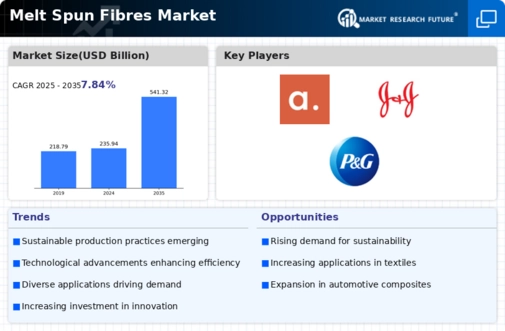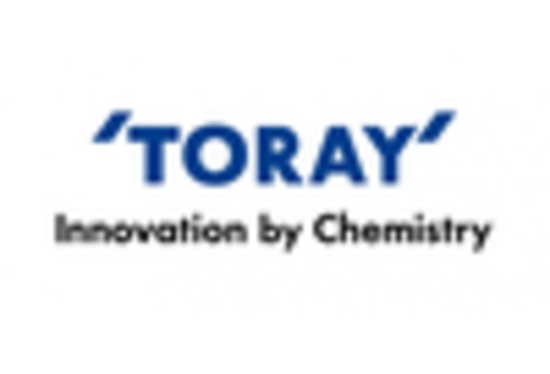Rising Demand for Eco-Friendly Products
The Melt Spun Fibres Market is experiencing a notable increase in demand for eco-friendly products. As consumers become more environmentally conscious, manufacturers are compelled to adopt sustainable practices. This shift is reflected in the growing preference for melt spun fibres, which are often derived from recycled materials. The market for these fibres is projected to expand significantly, with estimates suggesting a compound annual growth rate of around 5% over the next few years. This trend indicates that companies focusing on sustainability may gain a competitive edge, as they align their offerings with consumer values. Furthermore, regulatory pressures aimed at reducing plastic waste are likely to bolster the adoption of melt spun fibres, further driving growth in the industry.
Growing Consumer Awareness and Preferences
Consumer awareness regarding the benefits of melt spun fibres is on the rise, significantly influencing the Melt Spun Fibres Market. As individuals become more informed about the advantages of these fibres, such as their moisture-wicking properties and ease of care, their demand is likely to increase. This heightened awareness is particularly evident in the apparel and home textiles sectors, where consumers are seeking high-performance materials that offer both functionality and comfort. Market data suggests that the demand for melt spun fibres in the textile industry could grow by approximately 7% annually, driven by changing consumer preferences. Companies that effectively communicate the benefits of their melt spun fibre products may find themselves well-positioned to capture a larger share of the market.
Expanding Applications Across Various Industries
The versatility of melt spun fibres is driving their adoption across a multitude of industries, thereby propelling the Melt Spun Fibres Market forward. These fibres are increasingly utilized in sectors such as automotive, construction, and healthcare, owing to their unique properties such as durability and lightweight nature. For example, in the automotive industry, melt spun fibres are used in interior components and insulation materials, contributing to weight reduction and improved fuel efficiency. The healthcare sector also benefits from these fibres, particularly in the production of medical textiles and personal protective equipment. As industries continue to explore innovative applications for melt spun fibres, the market is expected to witness sustained growth, with projections indicating a potential increase in demand by over 10% in the coming years.
Increased Investment in Research and Development
Investment in research and development is a key driver for the Melt Spun Fibres Market, as companies strive to innovate and enhance their product offerings. This focus on R&D is essential for developing new applications and improving the performance of melt spun fibres. As competition intensifies, manufacturers are allocating more resources to explore advanced materials and technologies that can elevate their products. The trend indicates that firms investing in R&D may achieve a competitive advantage, as they are better equipped to meet evolving market demands. Furthermore, collaborations with research institutions and universities are likely to foster innovation, leading to breakthroughs that could redefine the melt spun fibres landscape. The potential for new product development in this area appears promising, suggesting a vibrant future for the industry.
Technological Innovations in Production Processes
Technological advancements play a crucial role in shaping the Melt Spun Fibres Market. Innovations in production processes, such as improved spinning techniques and enhanced polymer formulations, are enabling manufacturers to produce higher quality fibres at reduced costs. These advancements not only enhance the performance characteristics of melt spun fibres but also contribute to increased production efficiency. For instance, the introduction of automation and smart manufacturing technologies has the potential to streamline operations, thereby reducing lead times and waste. As a result, companies that invest in these technologies may experience improved profitability and market share. The ongoing research and development efforts in this sector suggest a promising future for the melt spun fibres market, as new applications and products emerge.


















Leave a Comment